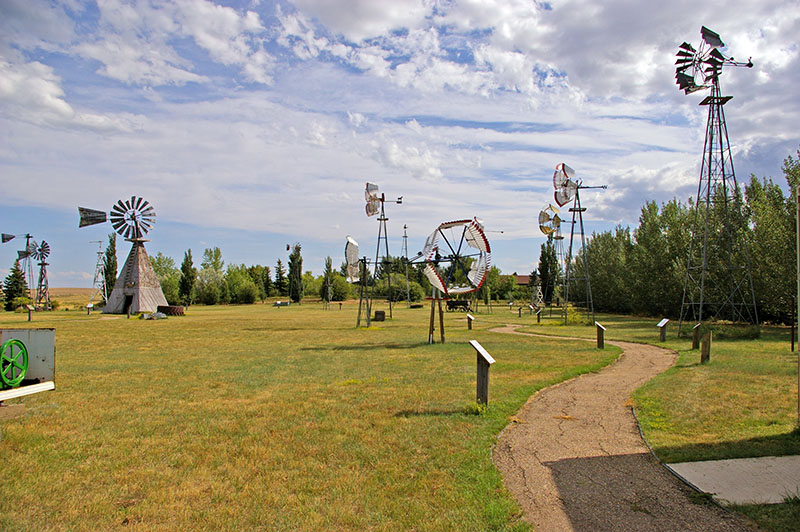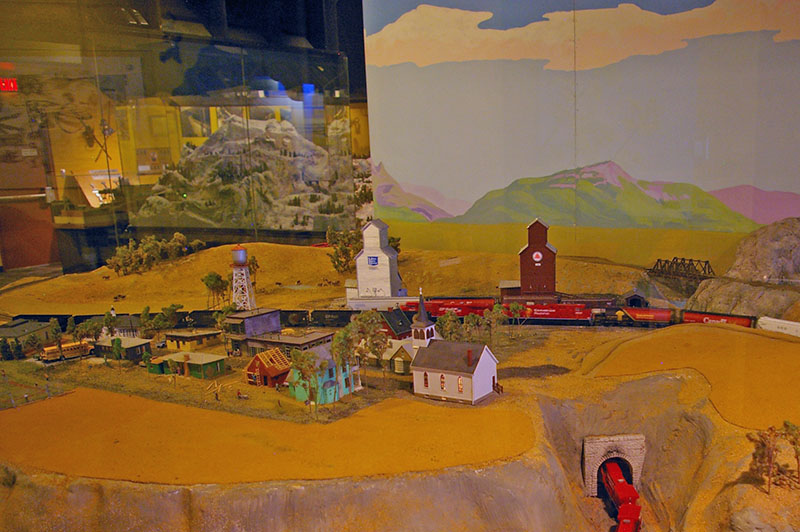
Description: More than two-thirds of the small town and rural museums in Alberta can be classified as heritage museums, that is, museums that celebrate the history of the region with a series of exhibitions about its founders, early settlement, agriculture, and pioneers. The collections typically conform to a white colonial settler narrative, noting how immigrants to the region overcame its harsh conditions to create farms, small businesses, and industries. These museums tend to have a similar range of objects, including defunct communication and medical technologies, military costumes, kitchen implements, and old school desks and books, classifying them both chronologically and by type, in glass cases that feature industrial, technological, and domestic life from the late nineteenth and early twentieth centuries. Many of these small museums have expanded to include exterior grounds on which sit a range of historic buildings, either from the immediate town or farther afield, as well as stockpiles of rusting farm equipment. Such museums are typically founded by volunteer societies trying to display the objects donated after periods of technological change, industrial decline, or other major changes in the town. The displays both memorialize what has come to be labelled as the past, and provide storage space for items of liminal value, which are simultaneously deemed worthless and worth preserving. Often acquired by donation rather than deliberately collected, the items in such museums reflect the material culture and values of the communities from which they originate. Many such items are linked to local historic families or businesses, embedded in stories of local significance related to the settler narrative. Typically, Indigenous peoples are a small part of the exhibitions, represented in a display of arrow heads or tourist crafts, producing stereotypical narratives of First Nations cultures as part of the past rather than the present, or with a historical reconstruction of a teepee or trading post. At the same time, these displays are open ended because of lack of completion and significant textual accompaniment. The most successful heritage museums have multiple purposes, acting as social centres, hosting various events, and linking with other organizations in the town.
Heritage is itself a contested term and has been theorized in complex ways within the field of critical heritage studies. One key scholar is Laurajane Smith, who, in her well known book, Uses of Heritage (2006), argues that heritage is a cultural construction both embedded within and regulated by powerful professions, institutions, and government departments. She theorizes that Authorized Heritage Discourse (AHD) tends to favour expert knowledge about the past, while fetishizing its material manifestations and tending toward a conservative identification with the nation and reassertion of dominant identities. All the same, she contends that identity is not simply represented by heritage places, but rather is actively and continually recreated and negotiated as people, communities, and experts reinterpret and reassess the meaning of the past in terms of the needs of the present.



Feature Museum:
Caroline Wheels of Time
Click the image for more photos of Caroline Wheels of Time
At first glance the Wheels of Time museum in Caroline is a typical heritage museum, consisting of a small historical village built from relocated and restored structures. These include a schoolhouse and teacherage, a trapper’s log cabin, a two-storey homesteader’s log house, and Caroline’s original village office/fire hall. But inside these buildings, one does not find the usual clutter of haphazardly-collected artifacts. Although some buildings have been decorated to represent specific periods, the main interpretive area is a clean, bright, open space with modest-sized temporary exhibits.
Under the stewardship of curator Debbie Nelson, the museum greatly reduced the size of its material collections, partly to alleviate the difficulties of storage, restoration, and accessioning. This was an unusual approach as aging museum boards often resist the notion that collections can be dispersed without eroding the museum’s function. Instead, Wheels of Time has introduced a variety of cultural activities, including renting out its heritage fire hall, providing a local crafts store, pie shop, and nature walk, and hosting the local farmer’s market. There are also outdoor film screenings, a genealogical research station, and educational programming. One of the more unique programs is a heritage schoolday, in which children of all grades attend a full day of class in the style of a one-room schoolhouse, with a costumed, in-character teacher. Finally, the museum operates a small campground and RV park next door, further expanding its income generation.
With such a wide range of activities the Wheels of Time has quickly become Caroline’s cultural heart, and has raised the profile of both the town and the museum.



Other Heritage Museums:
Fort Heritage Precinct

Click the image for more photos of Fort heritage Precinct
This well-developed site in Fort Saskatchewan is a full recreation of the original fort, very near its original location further downstream. Spearheaded by city council, the new facility recently opened after five years of research and construction. Three periods are addressed: the NWMP fort, settler years and prominent citizens, and the old jail, which occupied the current site until 1988. Except for the warden's home, which houses the offices, gift shop, and a small exhibition on the jail’s history, this particular aspect of Fort Saskatchewan has been erased from view. However, the jail had a major social impact over the decades, with its 800 acre farm, livestock, and work programs that saw inmates cutting river ice and firewood for residents, and building local roads. Nevertheless the artifacts, photographs, and a model of the jail grounds provide a fairly complete picture of the period. The fort itself features reconstructions of most of the original buildings and stockade, with an interpretive area occupying half of the reconstructed stables. Everything is fresh-hewn, as it would have been, rather than artificially aged. The quality and variety of exhibits is excellent, with much effort put towards providing school groups with an experience of life in the 1880s. Finally, the pioneer village has several relocated structures including two schools, a church (still consecrated), several homes, and a brick courthouse.
Etzikom
Museum

Click the image for more photos of Etzikom Museum
Famous for its collection of historic windmills, Etzikom also has an 11,000 square foot museum with an ice cream shoppe. A newly relocated historic church next door is awaiting restoration as well. The museum has themed rooms typical of heritage museums, with an excellent natural history room as well as rooms dedicated to musical instruments, archaeology, and a replica main street with boardwalk. Outside, sixteen windmills of various sizes and designs are set along a winding path, including a single massive blade from a modern power-generating windmill. Nearby is an exhibit with agricultural implements, each mounted on a gravel bed with donor plates. Unfortunately, as the windmills can only be displayed outdoors, some have deteriorated and have had to be taken down. The museum is quite active on social media, offsetting its remote location south of Medicine Hat.
Grain
Academy and Museum

Click the image for more photos of Grain Academy and Museum
Located in the BMO Centre on Calgary’s Stampede grounds, this museum is dedicated to the history of grain production in Canada, with a focus on the changing technology of grain elevators and the logistics of moving grain across the country. To this end some innovative exhibits have been built, including an 8-foot elevator model in two halves with working parts that actually moves grain visibly from the bins to the railcar. The main exhibit, however, is a massive custom-built HO-scale train model, showing the collection of grain on the prairies, the route through the mountains, and the terminal on the West Coast. Starting the train initiates a voiceover which explains the process, and ends with a short video about the modern ocean freight terminal. Other models show different styles of elevator, including a portable one intended to support regions where an elevator might have burned down. In practice this elevator was only moved twice as it was impractical to reassemble. The curator, Alan Walsh, is a third-generation elevator man and very enthusiastic about his field. However, the museum suffers from poor attendance despite its ideal location, as signage on the grounds is lacking. Given the high attendance for Stampede each summer, many visitors remain unaware of the museum’s existence, an ongoing problem that the Stampede management has yet to rectify.


 Town as Museumtop of page
Town as Museumtop of page












 Town as Museumtop of page
Town as Museumtop of page